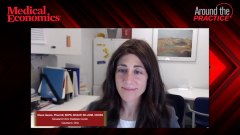
Case Study: Optimization of Heart Failure Therapy with an SGLT-2 Inhibitor
Muthiah Vaduganathan, MD, MPH, presents a case study for a patient hospitalized with heart failure whose therapy was optimized with an SGLT-2 inhibitor.
Episodes in this series

Dhiren Patel, PharmD, CDE, BC-ADM, BCACP: Excellent. Thank you for that. Like I said, we have a lot of different tools in our toolbox. It’s always nice to understand and help our primary care colleagues. They have a lot on their plate. They have a lot that they need to do within a 15-, 20-, 30-minute visit, and it’s also nice to be able to share some of these best practices in clinical pearls as they sort through some of their options and as they talk to their patients.
I’d love to talk about a real-life case and how we’re using some of this hot-off-the-presses, so to speak, information, and how we’re incorporating that into practice. We have a patient case. This is a 64-year-old woman with a history of hypertension, peripheral artery disease, and chronic kidney disease, that is newly hospitalized for heart failure. Dr. Vaduganathan, if you could walk us through your approach and what you were thinking as you saw this patient.
Muthiah Vaduganathan, MD, MPH: Yeah, exactly. This is kind of the prototypical person we’re meeting now, who is newly diagnosed with heart failure, in this case with reduced ejection fraction. She was diuresed in the hospital with loop diuretics. She’s now clinically improved. She actually feels quite well. Her transthoracic echocardiogram showed an ejection fraction of 30% and she had moderate mitral regurgitation. She has preexisting kidney disease. Her estimated glomerular [filtration rate] is 45 and she has a nonischemic picture with nonobstructive coronary disease on angiography.
So now we’re meeting her and we’re engaging more closely in her care as we approach discharge, and the clinical question comes up, what do we do next? Her blood pressure is 95 to 100 mmHg, her systolic blood pressure, her heart rate is 85 BPM, and she’s otherwise fairly euvolemic. At present, she’s on low doses of 3 pillars. She’s on metoprolol succinate, 25 milligrams [mg]; lisinopril, 2.5 mg; and spironolactone, 25 mg, and she’s also on a modest dose of a loop diuretic as well as aspirin and a statin. The question becomes in heart failure management today, we now have multiple options. We can up-titrate this patient to target doses of her existing therapies, we can switch her from lisinopril to sacubitril/valsartan, which has been shown to have incremental potential in improving survival, or we can initiate an SGLT-2 [sodium-glucose cotransporter-2] inhibitor.
I think this is becoming increasingly common in terms of multiple potential decisions that can still benefit patients. In this case, we chose to start dapagliflozin, 10 mg once daily. And I think the primary reason that supported that decision was that her blood pressure was borderline. She was already on low doses of other therapies, and we know that probably touching on each of these pillars, each of these components, is important in modifying pathophysiology. So that was the decision we made. Since she was clinically euvolemic, we didn’t alter her diuretic dose. And, importantly, in both DAPA-Heart Failure and EMPEROR-Reduced, there were really minimal diuretic changes during the course of the trial for most patients. A minimal subset, 10% to 15%, required dose de-escalation, down-titration, during the trials. She was closely followed, and otherwise has done well and she’s awaiting follow-up with repeat echocardiography.
Dhiren Patel, PharmD, CDE, BC-ADM, BCACP: Excellent, that’s really helpful. I have a follow-up question for you there. In a lot of the heart failure trials, we saw these target doses that we were always aiming for, and you mentioned the 3 pillars, now we have a 4th pillar. Is it more important now to making sure there is 4 pillars on board versus the initial approach that we had of getting everyone to target? How are you now thinking about this 4th pillar? For those of us that don’t do heart failure on a daily basis, but now we are because the same way diabetes is becoming a disease that you guys now have to be more attuned to, we’re seeing concurrent heart failure in our patients with diabetes. What would your thoughts be there?
Muthiah Vaduganathan, MD, MPH: Unfortunately, we don’t have direct clinical trials comparing, for instance, high doses of 2 therapies, 2 pillars, versus low doses of 4 pillars. That said, indirect evidence does suggest that a more comprehensive approach of low doses of multiple therapies is the path forward. That indirect evidence comes in a few lines. First is that there have been direct dose comparison trials for ACE [angiotensin-converting enzyme] inhibitors and ARBs [angiotensin receptor blockers], where low doses and high doses were compared, and on average there were no survival benefits of higher doses. But at higher doses, people did appear to have a hospitalization benefit. People remained out of the hospital to a greater extent. For beta blockers, probably the therapy with the clearest dose response, higher doses do appear to provide incremental advantage. For the MRAs [mineralocorticoid-receptor antagonists] and of course SGLT-2 inhibitors in heart failure and CKD is fixed dosing, that question is less relevant.
So, in general, based on that and extrapolating from that, touching on multiple therapies especially since all these therapies work on distinct mechanistic pathways and targets, we would anticipate that their benefits in practice would also be additive when combined. So that has been our approach and that’s been also supported in more expert consensus pathways. But unfortunately, I don’t think that there will be, at least in the near term, a planned clinical trial investigating combination versus various combinations.
Dhiren Patel, PharmD, CDE, BC-ADM, BCACP: That’s really helpful. One thing that we all heard today, and we can all agree on, that we’re never just managing one condition. If it’s diabetes, we’re also dealing with other comorbidities, and if it’s heart failure, we’re dealing with CKD and a long list of other things. This has been an excellent discussion and we hope you found this information to be useful. Thank you all for watching this Medical Economics Around the Practice program. Thank you all for joining us today.
Transcript edited for clarity.
Newsletter
Stay informed and empowered with Medical Economics enewsletter, delivering expert insights, financial strategies, practice management tips and technology trends — tailored for today’s physicians.


















